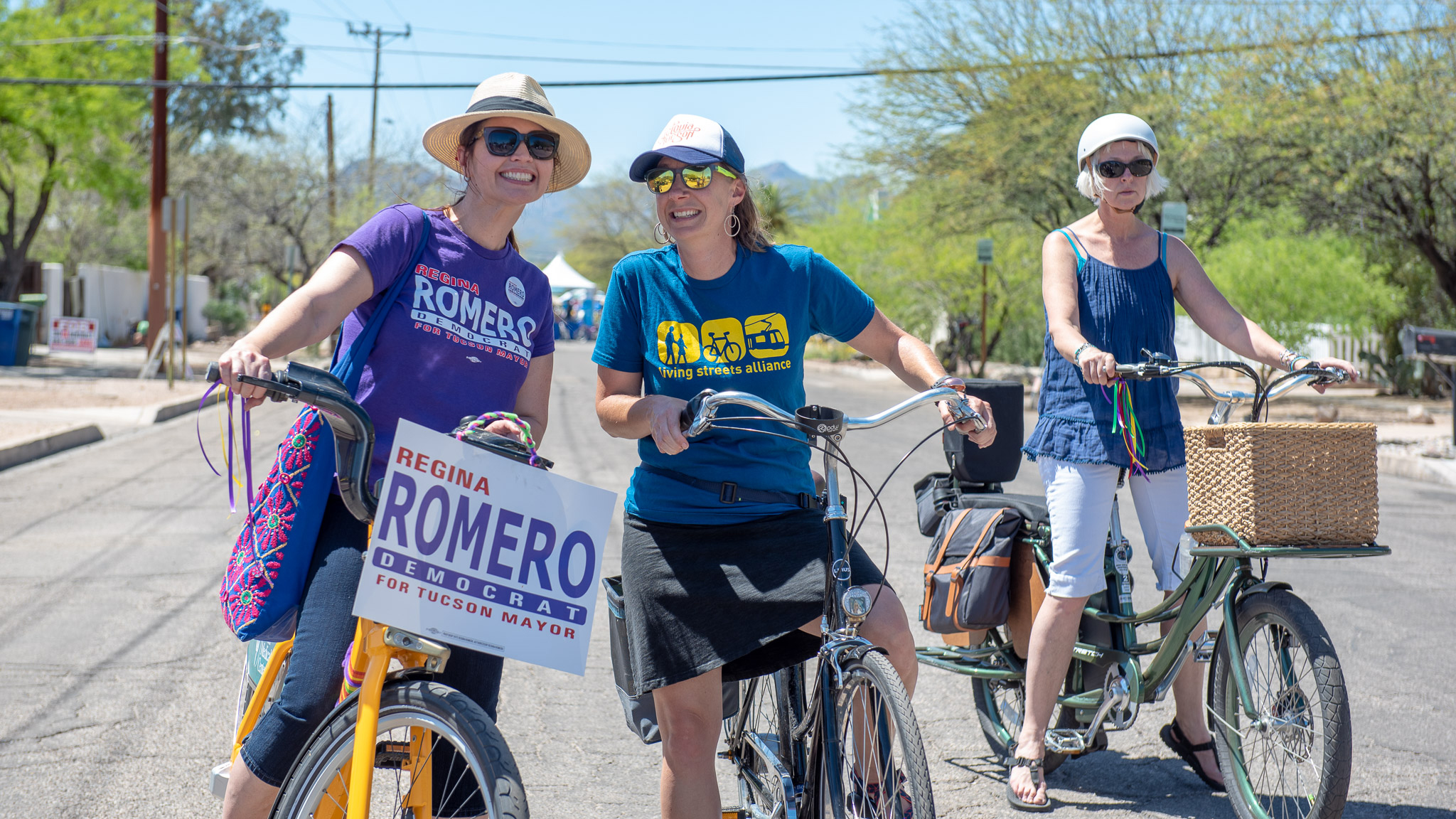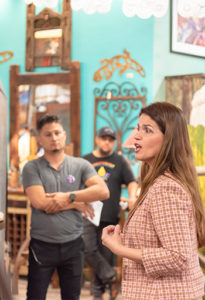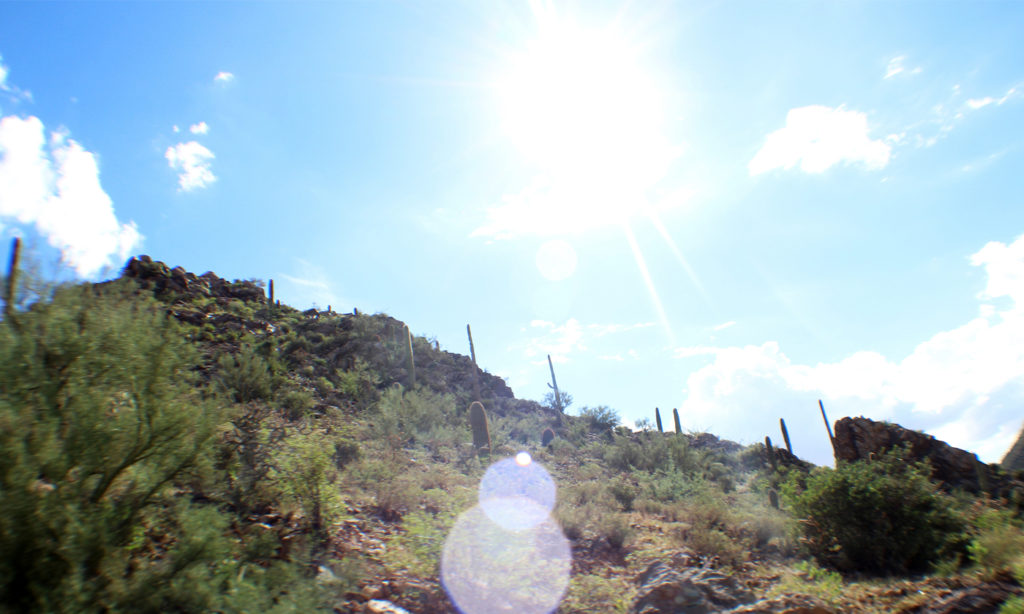A Conversation with Mayor Regina Romero

On December 2, 2019, Regina Romero made history when being sworn in as Tucson’s first female and first Latina mayor. At the end of November, I spoke with her about her background and what led her to the mayor’s seat, along with conversing about political, gender and racial power structures; environmental issues; Tucson’s arts, culture, and history; and the city’s transportation concerns. Some quotes have been edited for length and clarity.
Born in Yuma and raised in Somerton, Arizona, Regina Romero has been a Tucsonan since 1992—drawn here both by siblings who moved to Tucson for education and economic opportunities, and by her being accepted to study at the University of Arizona. While taking classes at UA and Pima Community College, Mayor Romero became inspired to get involved with politics after taking a Chicano studies class at Pima with Professor Lupe Castillo.
“We talked about Chicanismo, about the history of the land and Mexican-Americans living for many generations in the Southwest (pre-Gadsden Purchase), and activism. We also talked about policy and needs, and the lack of participation of women and people of color in our democratic process. That really sparked a nerve with me,” Mayor Romero recalls.
Through her studies, Mayor Romero became a student activist. In 1995, she was invited to get involved with the Ward One City Council race, help with voter registrations, and go door-to-door to talk to constituents about issues and ask for their votes.
“I started getting involved with community, and that’s what started my passion for the political process, in electing women and people of color that would represent the needs that I felt were important to me,” Mayor Romero says.
According to the 2010 U.S. Census, 42.9 percent of Tucson’s populace identifies as Hispanic or Latina/o/x. Considering that Romero was Tucson’s first Latina elected to the Tucson City Council in 2007 and is now the first Latina mayor, we discussed the power structures that keep women and people of color, and especially women of color, from running for and being elected to public office.
“It took a lot of years for me to even realize, ‘Oh, I could do this,’” Mayor Romero shares.
It took 12 years from becoming politically activated to her running for and winning her Ward One City Council seat in 2007. Through her deep involvement with community, when the position vacated, she was called upon to fill it.
“People started calling me saying, ‘Hey, you are the cofounder and the chair of Las Adelitas,’ a group that encourages political participation with Latinas and our families. So, they were saying, ‘Isn’t that the mission of your organization?’”
Romero heeded the call with some concerns, especially since she had an 18-month-old son at the time. The support of her husband and family was, and is, key considering that city councilors are paid $24,000 and the mayor’s salary is $42,000—a wage that hasn’t changed since 1999. Again in this year’s election cycle, voters said no to raises, thereby directly affecting the ability of mayor and city councilors to concentrate full-time on Tucson, since they have to work outside of their elected positions to make ends meet. The current gross annual salary of a councilperson is equivalent to a full-time, minimum wage job in Tucson as of January 1, 2020— at $12 an hour.
“That lack of living wages for elected officials—that’s both for the state and for city mayor and council—has been an impediment for other women and other workers of the community to step up and run,” Romero explained. “What we’ve seen is that either independently wealthy males or retired males have been ready and willing to not care about that pay to be able to serve. For me and my family, it’s been a struggle.
“In terms of why we see such lack of participation of women, especially women of color in our political processes, it’s because we continue perpetuating a cycle of racist systems that were not created for us. If you’re a working person, if I were a single mom with my two kids, there’s no way I would have ever been able to run. My husband is the breadwinner. I’ve also had to work, and for the last three years, I’ve had an amazing job with Center for Biological Diversity as the director of Latino engagement, which has been very flexible with me.”
At the top of Mayor Romero’s platform is addressing environmental concerns such as recycling, sustainability, and resiliency in the face of climate change. She explained that it is important for the city to partner with entities such as the UA, local and national environmental nonprofits, and ASU on these issues.
“It is about finding solutions together for the biggest problems that we have as a society and a city. We have to change our mentality from ‘I can consume whatever I want and I can recycle it’ to ‘How do we reduce waste?’ Reduce, reuse, recycle. We have to reeducate our community and find a better way, because Trump is fighting with China, and China says, ‘No, we’re not going to take your trash.’”
When campaigning, Mayor Romero said that Tucsonans shared their climate change concerns, such as the rising temperature, the heat island effect, and water resources.

When it comes to water stewardship, Tucson Water has led the way in Arizona with its water-saving incentives such as offering rebates for residential rainwater and greywater harvesting systems, along with installing high-efficiency toilets and clothes washers. This fall, mayor and council passed a green infrastructure plan that will help direct stormwater that collects along Tucson’s streets into streetside basins. These efforts will provide water sources for planting and establishing trees in neighborhoods, which will help mitigate flooding and the heat island effect.
Tying into the above climate issues includes tackling carbon emissions. According to a 2017 study by the Environmental Protection Agency, transportation (cars, trucks, ships, trains and planes) accounted for 28.9 percent of greenhouse gas emissions. Mayor Romero’s platform calls for transitioning the city’s vehicle and bus fleet to 90 percent electric by 2032, reducing single-occupant vehicle commuters from 76.5 percent to 50 percent by 2035, and implementing a transit system that is affordable and reliable.
“The City of Tucson hasn’t seen a bus rapid transit system. Once one is implemented, it is much less expensive than rail and as effective, and sometimes even more effective, because the most effective rapid transit, in any city, has the fewest stops. You want to get people moved fast to where they need to go. And so the City of Tucson is thinking about a tapping into federal transit-oriented development funds.”
In November, Romero was in Washington, D.C. for a conference and took the opportunity to set up meetings with federal agencies and met with the Federal Transportation Administration Administrator K. Jane Williams to discuss rapid transit, what makes those systems work well, and what to include in Tucson’s application for FTA funding.
“It was awesome to be able to have that conversation with her. It’s about diversifying our transit and mobility choices in Tucson. And as we look at the possibility of a potential expansion of a streetcar, we can’t forget that there is bus rapid transit that is successful in other cities. We’re studying the highest-used transit lines in the city, and of course we’re going to get input from the community.
“It’s important to start thinking as a jurisdiction about what makes sense and how to do it equitably, to make sure that we do not displace families, that we create affordability and maintain affordability to those lines that we want to see happen. We have to plan ahead and look holistically at how it’s going to affect the city of Tucson.
“We have to look beyond what we’ve traditionally done to move to the next level of progress.”

What do you love about Tucson, and its arts, culture, and history?
I love that Tucson is surrounded by mountains. I love the desert. I love the culture in Tucson. It feels like a small town, like everyone knows each other. Even if you don’t, people treat each other like they know each other. The food is amazing, and that’s why we’re a UNESCO City of Gastronomy. The history is amazing and so rich. It has been Tohono O’odham territory and Yaqui land. We were Spain once, then Mexico, then a U.S. territory. Tucson has always been very multicultural, with deep roots of Chinese, Mexican, Irish, and Jewish people. It’s a basin of different cultures here.
The arts scene is so awesome. It has its own unique funk and vibe. Tucson has a history of muralists and painters. We need to make sure that we follow and continue the tradition. What I’ve loved recently was seeing those murals throughout the community, especially concentrated in downtown, become again an attraction to people. People love them. We should expand on that and expand on making sure that we’re inclusive in celebration in arts of both color and the representative communities. We could make art available and easy to access for students and for working families throughout the city of Tucson. We need to continue investing not only in that but also arts programming in our parks; continue investing in the local talent that we have here and make art available and accessible, maybe by partnering with the school districts with their arts programs.
And, street art. Why not use art on the street? There’s this movement happening right now, called tactical urbanism, that promotes art on the street and that actually provides safe spaces for bicycles and pedestrians to use. It’s really cool. So, there’s many, many ideas and concepts that we can push on to expand that investment that we do as a community in the arts.
Category: The Scoop




